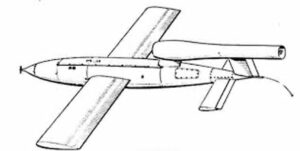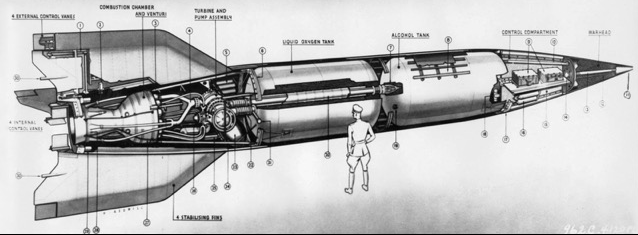Camp Dora and the Mittelwerk, The Harz, Germany
This paper is a brief history of Camp “Dora” and the associated Mittelwerk located in the Harz district of Germany.
Situated towards the northern part of Germany is the Harz district, an area comprising a series of mountain ranges, dense woodland and lakes, all contained within an area about 110 km (68 miles) in an east west direction, and 35 km (22 miles) north to south. The Harz is characterised by countryside of outstanding natural beauty and a number of historic and very picturesque towns such as Goslar, Wernigerode and Quedlinburg, the former and latter both being UNESCO world heritage sites.
During the cold war era, slightly more than half of the Harz was held by the GDR (German Democratic Republic) and therefore under the influence of the Soviet Union. The demarcation line between the GDR and the FRG (Federal Republic of Germany) ran north to south, roughly bisecting the Harz. It was a “hard” border with fences, obstacles, minefields, observation posts and armed guards.
The most prominent peak in the Harz is the Brocken at a height of 1141 m (3,743 ft). From the summit there are commanding views in every direction over the surrounding countryside. As the Brocken was formerly in GDR territory, it provided an excellent point on which to construct a telecommunications surveillance and listening post for monitoring Western communications. The buildings and masts erected for this task are still in place on the Brocken, but are now just a legacy of the cold war and relegated to being tourist curiosities.
A metre gauge railway system runs through the Harz, with its main operating base, sheds, splendid workshops, etc, situated at Wernigerode. The line has a branch to the Brocken and the summit is attained on tightly curving tracks by adhesion worked steam & diesel locomotives. The impressive Class 99, 2-10-2 tank locomotives of the DRG ( Deutschen Reichsbahn) used on the line are the most powerful narrow gauge locomotives to have been built in Germany.
The above description is of the Harz today;
over eight decades ago the situation was very different.
On the night of 17/18th August 1943, RAF Bomber Command mounted operation Hydra, an attack on the German experimental research establishment at Peenemünde, situated on the Baltic coast. This attack had been sanctioned in the strong belief, based on sound intelligence from several different sources, that research and development into advanced weapons systems was being carried out there. This assumption proved to be correct. In fact, two key weapons were being developed at Peenemünde. They were the Fiesler Fi.103 pilotless flying bomb, for which the Luftwaffe had responsibility, and the liquid fuelled A4 rocket under the control of the German army. They respectively became rather better known known as the V1 and V2 weapons, the designations derived from the word Vergeltung, for retribution or revenge.
The attack on Peenemünde was made by four hundred and thirty-three heavy bombers, guided by sixty five Pathfinders. Using the code name Whitebait, a small diversionary force of eight Mosquitoes bombed Berlin on the same night. Dropping “Window” (reflective aluminium strips designed to blind and confuse German radar), the Mosquitoes primary task was to draw away German night fighters from the main Peenemünde attacking force. Objectives of the Peenemünde raid included the destruction of crucial buildings within the research complex and the bombing of scientists’ accommodation in the hope that many key personnel would be killed.
The unexpected and sufficiently destructive raid on Peenemünde galvanised the German hierarchy into taking drastic action to disperse V weapons production to various underground sites, including the complex at Nordhausen. Other underground organisations involved in V1 and V2 production included the Vienna-Friedrichshafen group and a factory at Riga. However, Nordhausen, known as the Central Works, was to become the predominant location for both V1 and V2 missile assembly. Other organisations involved in manufacturing V1 and V2 components included Fiesler at Kassel, Volkswagen at Wolfsburg, Zeppelin at Friedrichshafen on Lake Constance, Raxwerk at Wiener-Neustadt and Demag at Berlin-Falckensee.
An underground complex of tunnels already existed from a somewhat earlier period in the war at a location just outside the town of Nordhausen in Thuringia, in the Harz. This site had been used to store certain vital chemicals for the Luftwaffe. One of these chemicals was Tetra-Ethyl-Lead, an essential anti-knock additive used in petrol for piston aero engines. These tunnels at Naudhausen were therefore designated to be greatly expanded to expedite V weapons production.
To facilitate the creation of a large underground production facility, known initially as the Mittelwerk, the German hierarchy endorsed the use of large numbers of slave labourers drawn from concentration camps, such as Buchenwald, to excavate the tunnels. Pursuant to this, in the late summer of 1943 a concentration camp to house this slave labour was erected at Nordhausen, adjacent to the tunnel complex. The camp became known as “Subcamp Dora.” This camp had most of the dreadful characteristics of other concentration camps, in that the inmates were housed in overcrowded huts contained behind electrified fences and fully guarded. It also had a small crematorium. The camp was administered by the SS.
It is reported that the initial drafts of labourers had a life expectancy of about six weeks, so harsh were the conditions in driving the tunnels. The complex of tunnels rather superficially resembled a ladder in layout, with two long parallel tunnels forming entrances and exits, with side tunnels (the rungs) excavated between them. As the war went on further expansions to the complex were planned. Some of these expansion plans were realised and others were not. The Mittelwerk Central Works was eventually to become the largest underground factory in the world. A4 (V2) Rocket production began in January 1944, and by May had reached 400 units per month. However, this was way below the projected 1,000 units per month. Failures and faults plagued the project; dust laden tunnels can hardly have been conducive to producing trouble-free precision assemblies! Also, there must have been many cases of sabotage!
In actual fact “Subcamp Dora” was only one of about forty individual camps spread across the Harz area. Collectively, in the autumn of 1944, these camps came to be known as the Mittelbau. It is said up to April 1945 more than sixty thousand inmates had passed through the Mittelbau. During this same period over twenty thousand had perished. Camp Dora was liberated by troops of the US Army on 11th April 1945, just ahead of their Soviet counterparts. One of the principal tasks of the Americans was to remove as much V2 rocket material from the Mittelwerk as possible. This probably explains why there is so little, if any, V2 material visible today.
Nordhausen “Camp Dora” and the Mittelwerk can be visited by the public, although access to the tunnel system is only permitted via a pre-booked guided tour. The site boasts a fine museum dedicated to the history of Camp Dora, its inmates and the Mittelwerk. In the museum there are many documents related to the setting up and operation of the camp and the Mittelwerk. Many of these documents bear the signatures of prominent Nazis, Albert Speer, Himmler, etc, etc. Very little is left of the camp itself, except the stone stanchions of the main gate, an obvious watch tower and a few lengths of narrow-gauge railway track. The tunnel system is a little more rewarding, and when one’s eyes become acclimatized to the available light, there are interesting objects to be seen. Most of these comprise V1 components of one sort or another, haphazardly strewn throughout the tunnels. Some of these components are readily identifiable, such as the fibre-wound spherical compressed air bottles used in the V1 flying bomb. This then is Nordhausen today, a memorial to human endeavour, extreme cruelty and ultimately man’s stupidity.
After the war there were several trials conducted by the Allies of German personnel associated with Camp Dora and the Mittelwerk. Only one SS guard was executed. By and large most got away with their heinous crimes.
Copyright © J F Willock August 202
References:
- The Mare’s Nest: The German Secret Weapons Campaign and British Counter-Measures: David Irving, William Kimber, London, 1964.
- Mittelbau-Dora Concentration Camp, 1943-1945: Edited by Jens-Christian Wagner, Wallstein.
- German Secret Weapons of the Second World War, Ian V Hogg, Greenhill Books, London and Pennsylvania, 1999.
- Raketenspuren, Peenemünde 1936-1996.: Volkhard Bode, Gerhard Kaiser, Bechtermunz Verlag. Augsburg, 2000.
A collection of photographs taken by Richard Willock on a visit to the complex in Summer of 2025


















